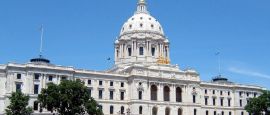Minnesota History, Language and Culture
History of Minnesota
The French established relations with the Native Americans in 1671 when they created treaties with several tribes allowing trade. In 1721, Fort Beauharnois was built to accommodate the large number of explorers passing through the area searching for the Northwest Passage.
The area remained mostly uncolonised and largely unexplored until part of modern day Minnesota was given to the United States after the American Revolution; they acquired the rest with the Louisiana Purchase in 1803.
Fort Snelling was established in 1819 and became a major outpost for the region, which was still predominantly unexplored until 1851, when treaties between the government and Native American tribes opened up the land of modern Minnesota for settlement.
Minnesota’s two largest cities, Saint Paul and Minneapolis, began developing in the mid- to late-1800s. The cities, known today as the “Twin Cities” because of their close proximity, quickly became the state’s epicentre with Saint Paul as the governmental capital and Minneapolis as the unofficial industrial centre. Today, the combined metropolitan area is home to over half of the state’s population.
Minnesota was signed into statehood in 1857 after much debate in the US Senate about the state’s slavery laws; Minnesota ended up being a free state, and joined the Union when the Civil War began. Once the war ended, settlement in Minnesota increased because of the railroad industry and a booming agricultural sector emerged in the region at the turn of the century.
The Great Depression hit Minnesota especially hard, causing severe layoffs in the newly developed mining industry. A drought disabled agricultural profitability. Like many other states, WWII stimulated the economy and created countless jobs. The Twin Cities Ordnance Plant was built by the US government to produce munitions during the war and Fort Snelling was a reception centre for new recruits after the draft began.
Today, farming has become a large industry in Minnesota and the state is a hotspot for innovation in the field; it is the largest producer of corn in the country. Mining, logging, and retail are all also large parts of the modern economy.
Language in Minnesota
Minnesota does not have an official language, though a bill was introduced by Minnesota House Republicans in 2011 to make English the state language. English is the most widely spoken language across the state, but small Spanish, German, and other foreign language populations exist as well.




 You know where
You know where